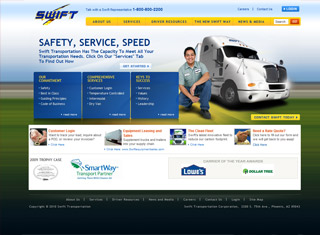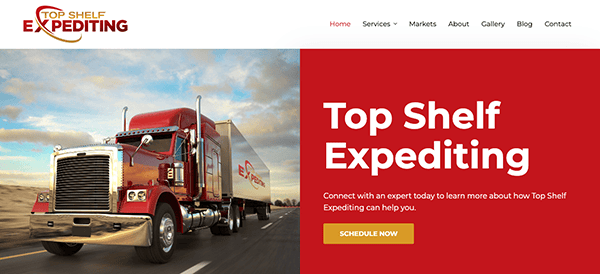Exactly How Specialized Transport Website Design Helps Improve Customer Engagement and Conversion
In today's affordable landscape, specialized transport website design plays an essential function in improving client interaction and driving conversion rates. By focusing on user-centric attributes, these internet sites not just streamline navigating however additionally adapt flawlessly to numerous devices, making certain accessibility for all individuals. Furthermore, the critical integration of visual aspects and clear call-to-action triggers can significantly affect customer habits. As we discover the vital elements that add to a successful layout, it becomes obvious that recognizing these elements can result in transformative results for organizations in the transportation field. What specific techniques have verified most reliable?
Value of User-Centric Layout
In today's electronic landscape, a user-centric style is vital for specialized transport internet systems - transportation web design. This approach prioritizes the requirements and choices of individuals, improving their general experience while navigating intricate transport services. By focusing on use, ease of access, and user-friendly navigation, companies can promote a feeling of trust fund and dependability among customers, which is critical in the transport industry
User-centric layout includes complete research to understand the target market's actions, inspirations, and obstacles. This expertise informs the growth of functions such as structured booking procedures, simple accessibility to solution information, and responsive consumer support. Furthermore, personalization can be incorporated to provide to private customer choices, bring about boosted interaction and complete satisfaction.
Executing a user-centric design not just improves the capability of transportation web systems but additionally enhances conversion rates. When users locate a platform very easy to browse and responsive to their demands, they are more probable to total transactions and return for future solutions. Inevitably, a well-executed user-centric style contributes to the general success of specialized transportation services by enhancing customer loyalty and encouraging repeat organization.
Effect of Aesthetic Elements
While the capability of a specialized transportation web system is necessary, the impact of visual components can not be neglected. A properly designed visual design plays an essential duty in capturing individual focus and assisting in details retention. Effective use shade, typography, and images not only improves the visual allure but likewise shares brand identification and professionalism and reliability.
Aesthetic elements, such as high-quality images of transport services, can evoke depend on and trustworthiness, motivating prospective customers to engage even more. Infographics and symbols simplify intricate details, making it extra digestible. This clearness can bring about decreased bounce prices and raised time invested on website, both of which declare indicators of user engagement.
Moreover, a constant aesthetic power structure overviews customers via the web site flawlessly, making certain that critical information-- such as solution offerings, rates, and call information-- is conveniently obtainable. This calculated plan assists to guide prospective clients towards desired activities, such as loading out a call type or read here requesting a webpage quote.

Mobile Responsiveness Benefits
The value of aesthetic aspects reaches mobile responsiveness, which is increasingly important in today's electronic landscape. As even more users gain access to internet sites through smart phones, a responsive style makes certain that content is shown ideally throughout various screen dimensions. This flexibility not only improves individual experience yet also considerably influences customer engagement and conversion prices.
Mobile responsiveness permits specialized transport firms to fulfill the assumptions of a varied clients. Customers are most likely to remain on a website that is simple to browse on their mobile phones or tablets, leading to longer session durations and lowered bounce prices. A mobile-friendly style builds credibility; clients are extra inclined to depend on and engage with a business that presents itself well on all devices.
Furthermore, internet search engine like Google prioritize mobile-optimized sites in their ranking algorithms. transportation web design. Businesses that spend in mobile responsiveness can boost their exposure and bring in even more organic website traffic. This enhanced exposure can convert into greater conversion prices, as potential clients are more probable to speak to or publication solutions through a site that operates flawlessly on their smart phones. Thus, mobile responsiveness is an important part of efficient website design in the specialized transport industry.
Streamlining Navigation Experience

A well-structured navigating experience is critical for specialized transportation websites, as it directly influences individual interaction and look at these guys fulfillment. When possible customers check out these websites, they anticipate to discover information swiftly and successfully. A structured navigating system can substantially improve this process, directing individuals perfectly through various solutions, rates alternatives, and get in touch with info.
To achieve optimal navigating, it is necessary to classify material rationally. Using a clear hierarchy-- such as key and second menus-- helps users recognize where to discover particular information without really feeling bewildered. Additionally, incorporating drop-down food selections can supply quick accessibility to subcategories, reducing click deepness, which is important for preserving user attention.
Furthermore, a search function enables customers to bypass navigating entirely, dealing with those that understand specifically what they look for. Implementing breadcrumb routes can additionally enhance the customer experience by providing an aesthetic pathway back to previous web pages, strengthening website structure.
Including mobile-friendly navigation is just as crucial, as many individuals access specialized transport websites on their smartphones. By prioritizing an user-friendly and receptive design, services can ensure that their web site effectively serves varied user requirements, inevitably enhancing customer engagement and conversion prices.
Integrating Call-to-Action Methods
Effective call-to-action (CTA) techniques are essential for directing individuals towards desired results on specialized transport websites. These methods not just enhance individual interaction however likewise significantly enhance conversion prices. CTAs ought to be strategically placed throughout the site, guaranteeing they are conveniently noticeable and available.

Including seriousness in CTAs, such as limited-time deals or special bargains, can additionally motivate customers to act quickly. A/B screening different CTA designs and placements can give important insights into what reverberates finest with the target market.
Additionally, ensuring that CTAs are mobile-friendly is extremely important, as a considerable section of users might access the site using smart phones. transportation web design. By thoughtfully incorporating these methods, specialized transport internet sites can properly lead users with the conversion funnel, eventually causing raised customer interaction and effective results
Conclusion
In verdict, specialized transport internet layout dramatically boosts customer interaction and conversion by prioritizing user-centric features, incorporating impactful aesthetic components, and making certain mobile responsiveness. Structured navigation experiences and well-integrated call-to-action techniques further contribute to a seamless user journey.